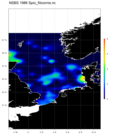
| Introduction | | Search taxa | | Taxon tree | | Taxon match | | Checklist | | Literature | | Stats | | Photogallery | | OBIS Vocab | | Log in |
CaRMS taxon detailsSpio Fabricius, 1785
129625 (urn:lsid:marinespecies.org:taxname:129625)
accepted
Genus
marine,
recent only
feminine
Fabricius, O. (1785). Von dem Spio-Geschlecht, einem neuen Wurmgeschlecht Nereis seticornis und Nereis filicornis, mit Abbildungen. <em>Schriften der Berlinischen Gesellschaft naturforschender Freunde.</em> 6: 256-270, plate V., available online at http://www.ub.uni-bielefeld.de/diglib/aufkl/schriftberlgesnaturfreunde/schriftberlgesnaturfreunde.htm
page(s): 258-259 [details]
Etymology Spio has its origin in the Greek mythology, designating one of the Nereids, the 50 daughters of Nereus by Doris, goddesses...
Etymology Spio has its origin in the Greek mythology, designating one of the Nereids, the 50 daughters of Nereus by Doris, goddesses of the sea, and patrons of sailors and fishermen. Spio (Speio, in Greek), was the nereid of the sea caves. [details]
Read, G.; Fauchald, K. (Ed.) (2024). World Polychaeta Database. Spio Fabricius, 1785. Accessed through: Nozères, C., Kennedy, M.K. (Eds.) (2024) Canadian Register of Marine Species at: https://www.marinespecies.org/carms/aphia.php?p=taxdetails&id=129625 on 2024-04-19
Nozères, C., Kennedy, M.K. (Eds.) (2024). Canadian Register of Marine Species. Spio Fabricius, 1785. Accessed at: https://marinespecies.org/carms/aphia.php?p=taxdetails&id=129625 on 2024-04-19
Date action by
original description
Fabricius, O. (1785). Von dem Spio-Geschlecht, einem neuen Wurmgeschlecht Nereis seticornis und Nereis filicornis, mit Abbildungen. <em>Schriften der Berlinischen Gesellschaft naturforschender Freunde.</em> 6: 256-270, plate V., available online at http://www.ub.uni-bielefeld.de/diglib/aufkl/schriftberlgesnaturfreunde/schriftberlgesnaturfreunde.htm
page(s): 258-259 [details] basis of record Bellan, G. (2001). Polychaeta, <i>in</i>: Costello, M.J. <i>et al.</i> (Ed.) (2001). European register of marine species: a check-list of the marine species in Europe and a bibliography of guides to their identification. <em>Collection Patrimoines Naturels.</em> 50: 214-231. (look up in IMIS) [details] additional source Meißner, K.; Bick, A.; Bastrop, R. 2011. On the identity of Spio filicornis (O.F. Muller, 1776)—with the designation of a neotype, and the description of two new species from the North East Atlantic Ocean based on morphological and genetic studies. Zootaxa (2815): 1-27, available online at http://www.mapress.com/zootaxa/list/2011/2815.html [details] additional source Fauchald, K. (1977). The polychaete worms, definitions and keys to the orders, families and genera. <em>Natural History Museum of Los Angeles County: Los Angeles, CA (USA), Science Series.</em> 28:1-188., available online at http://www.vliz.be/imisdocs/publications/123110.pdf [details] subsequent type designation Söderström, Adolf. (1920). Studien über die Polychätenfamilie Spionidae. <em>[published thesis].</em> Uppsala University, printed Almquist and Wicksells, 286 pp. [details]  Present Present  Inaccurate Inaccurate  Introduced: alien Introduced: alien  Containing type locality Containing type locality
From editor or global species database
Etymology Spio has its origin in the Greek mythology, designating one of the Nereids, the 50 daughters of Nereus by Doris, goddesses of the sea, and patrons of sailors and fishermen. Spio (Speio, in Greek), was the nereid of the sea caves. [details]Grammatical gender Spio, named after a female mythological entity, must be feminine, and has almost invariably been treated as feminine (with Spio decoratus one exception). [details] |
